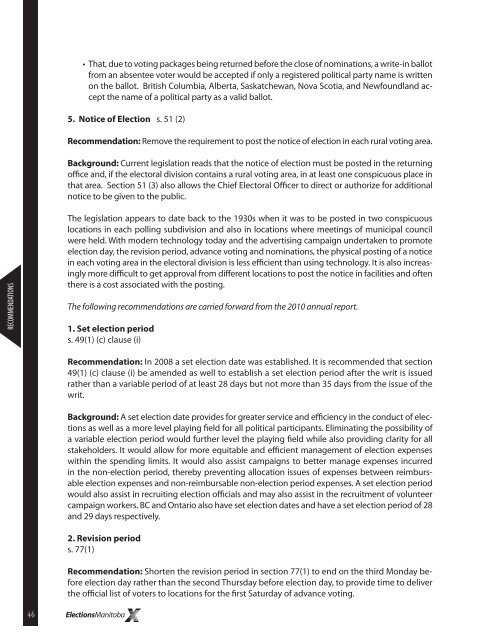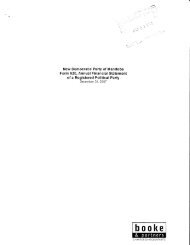Annual REPORT - Elections Manitoba
Annual REPORT - Elections Manitoba
Annual REPORT - Elections Manitoba
You also want an ePaper? Increase the reach of your titles
YUMPU automatically turns print PDFs into web optimized ePapers that Google loves.
• That, due to voting packages being returned before the close of nominations, a write-in ballot<br />
from an absentee voter would be accepted if only a registered political party name is written<br />
on the ballot. British Columbia, Alberta, Saskatchewan, Nova Scotia, and Newfoundland accept<br />
the name of a political party as a valid ballot.<br />
5. Notice of Election s. 51 (2)<br />
Recommendation: Remove the requirement to post the notice of election in each rural voting area.<br />
Background: Current legislation reads that the notice of election must be posted in the returning<br />
office and, if the electoral division contains a rural voting area, in at least one conspicuous place in<br />
that area. Section 51 (3) also allows the Chief Electoral Officer to direct or authorize for additional<br />
notice to be given to the public.<br />
RECOMMENDATIONS<br />
The legislation appears to date back to the 1930s when it was to be posted in two conspicuous<br />
locations in each polling subdivision and also in locations where meetings of municipal council<br />
were held. With modern technology today and the advertising campaign undertaken to promote<br />
election day, the revision period, advance voting and nominations, the physical posting of a notice<br />
in each voting area in the electoral division is less efficient than using technology. It is also increasingly<br />
more difficult to get approval from different locations to post the notice in facilities and often<br />
there is a cost associated with the posting.<br />
The following recommendations are carried forward from the 2010 annual report.<br />
1. Set election period<br />
s. 49(1) (c) clause (i)<br />
Recommendation: In 2008 a set election date was established. It is recommended that section<br />
49(1) (c) clause (i) be amended as well to establish a set election period after the writ is issued<br />
rather than a variable period of at least 28 days but not more than 35 days from the issue of the<br />
writ.<br />
Background: A set election date provides for greater service and efficiency in the conduct of elections<br />
as well as a more level playing field for all political participants. Eliminating the possibility of<br />
a variable election period would further level the playing field while also providing clarity for all<br />
stakeholders. It would allow for more equitable and efficient management of election expenses<br />
within the spending limits. It would also assist campaigns to better manage expenses incurred<br />
in the non-election period, thereby preventing allocation issues of expenses between reimbursable<br />
election expenses and non-reimbursable non-election period expenses. A set election period<br />
would also assist in recruiting election officials and may also assist in the recruitment of volunteer<br />
campaign workers. BC and Ontario also have set election dates and have a set election period of 28<br />
and 29 days respectively.<br />
2. Revision period<br />
s. 77(1)<br />
Recommendation: Shorten the revision period in section 77(1) to end on the third Monday before<br />
election day rather than the second Thursday before election day, to provide time to deliver<br />
the official list of voters to locations for the first Saturday of advance voting.<br />
46





